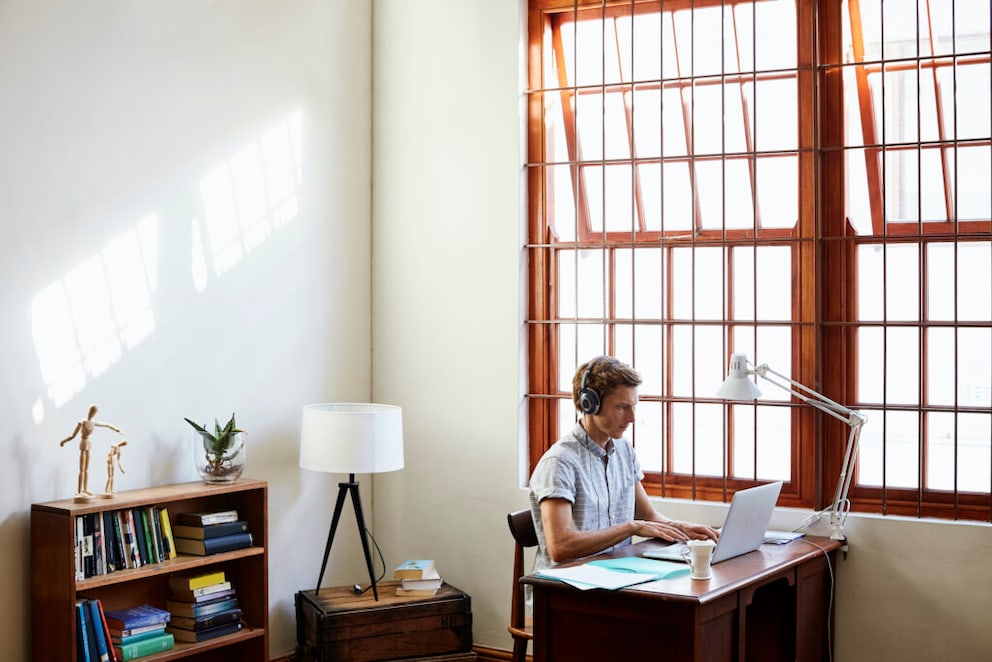April 20, 2025, 8:50 am | Read time: 5 minutes
In a home office, we spend most of the day at our desks. Good lighting is essential to work effectively. MyHOMEBOOK editor and interior designer Odett Schumann explains what the right lighting for a home office is.
We all know the image: the brilliant poet and thinker, working in a dark room with a dimly flickering desk lamp, honing the next groundbreaking idea. With today’s understanding of efficient and healthy work practices, it’s hard to imagine masterpieces being created this way. Now, as more people work from home, optimal lighting for productive work in a home office is especially important. Fortunately, there are now much better ways to achieve this.
Home Office Lighting: Consider the Light in the Entire Room
The challenge is that the light must be evenly distributed. If there’s a lack of light or if the existing light is unevenly distributed in the room, concentration and attention quickly suffer. Fatigue and increased errors are the result.
Multiple light sources are usually needed. At the desk, you’ll find zonal lighting, while the rest of the room is illuminated by diffuse, indirect light. The difficulty lies in combining the different light sources without creating harsh contrasts. A ceiling or pendant light that provides general illumination can counteract this effect and gently balance such contrasts.
To make the transition even smoother, a third light source, such as a floor or wall lamp, can be added. This way, there is a light source at every level of the room, creating a harmonious lighting ambiance. Finally, ensure that not too many different light colors are used, as they can create extreme light contrasts.
The Right Desk Lamp
Everyone has a different perception of light and thus different needs. For example, older people’s eyes require significantly higher illumination levels than younger individuals. A key criterion is that the desk lamp’s light should ideally be adjustable. A model with a dimming function is a particularly good choice for home office lighting, as it allows everyone to set the light intensity to their liking.

A good desk lamp is also characterized by being configurable as needed. For example, a flexible lamp arm can provide zonal lighting. This means the light beam should be adjustable to the exact spot where it’s needed. It’s also important that the light source doesn’t protrude from the lamp and cause glare. Additionally, the lamp’s housing should not reflect too much, as this can be distracting.
Positioning
Once you’ve found a suitable model, the seemingly simple question arises: How do I properly position my desk lamp? Ideally, place the lamp behind the monitor, or alternatively beside it. The lamp head should be adjusted so that it doesn’t glare at you or into the screen. The light beam should fall either from above or glare-free from the side. Only then will you have good lighting, and improved ergonomics at the workplace can also be achieved. If there are uncomfortable glares and reflections at the desk, we tend to unconsciously adjust our posture to avoid them. Over time, this can lead to tension, poor posture, and neck pain.
The Right Light for Home Office Lighting
Fact is: bluish light increases alertness and vitality. Reddish light, on the other hand, brings comfort and relaxation. We want a bit of both while working. So how do we solve this issue? The best option is cold white light at about 5,500 Kelvin, as this roughly corresponds to midday sunlight or daylight. What we don’t naturally get during the gray months, along with plenty of vitamin D, we must artificially provide. This color temperature is both motivating and energizing for the human body, making it ideal for effective and healthy work.
Away from the fall and winter months, a light color of neutral white or warm white, around 4,000 Kelvin, is sufficient. If a room lacks (artificial) daylight entirely, the body mistakenly assumes it’s nighttime, causing us to become tired and sluggish more quickly.
Aligning the Desk with the Light

The correct position of your desk is also crucial. Ideally, the desk should be near the window, allowing access to daylight, which also replenishes our vitamin D stores and lifts our mood. The desk should be positioned at a 90-degree angle to the window. A parallel alignment can harm our eyes over time, as it causes significant glare, not only when the sun is bright but also when the sky is filled with clouds. The contrast between the bluish monitor light and the white daylight can be too intense for our eyes over time.
Sitting with your back to the window is not an option either. In this case, the light falls unpleasantly into the screen, which our eyes must compensate for. Overexertion, headaches, and a negative impact on mood are the consequences. This position is also not ideal for video chats.

How Do You Find the Right Light Bulb?

5 privacy screen solutions in the home office

How to make a first-floor apartment brighter
Keep Not Only the Light but Also the Environment Bright
For many, an office filled with dark mahogany furniture or a black desk chair may seem stylish and chic—but these pieces are absolute light absorbers. It’s better to create a friendly atmosphere for the home office. Bright furniture complements bright light. But be cautious: a white desk can reflect strongly if bright light shines directly on it. It’s advisable to use light natural materials, such as a table made of birch or ash wood. The wall color should also be in soft tones like cream, light gray, or pastels.
It’s also wise not to overcrowd the home office. A windowsill overloaded with plants and decorations blocks incoming daylight. Keep it minimalist. Normally, mirrors and other reflective items in a room enhance the ambiance. In this case, it’s different: the reflective effect of mirrored glass doors or chrome accessories can be blinding to the eyes and distracting to the mind.

